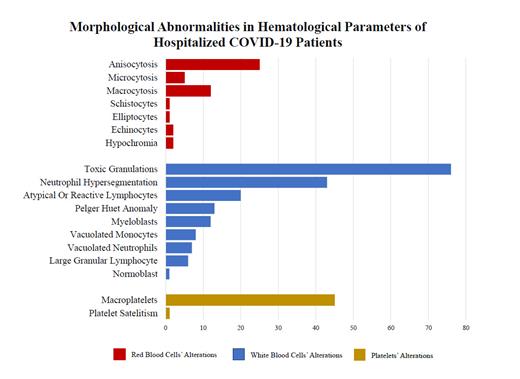Introduction
COVID-19 infection is known to significantly impact hematopoiesis and hemostasis, resulting in a wide range of hematological abnormalities. Notably, the pandemic has demonstrated higher mortality rates among the Hispanic population compared to other groups. However, limited comprehensive data exist on specific alterations in COVID-19 patients of Hispanic descent, which could offer valuable insights. This study aims to conduct a thorough examination of hematological changes in hospitalized COVID-19 patients of Hispanic descent, shedding light on unique aspects of the disease within this specific population.
Methods
We conducted a single-center cross-sectional study in Lima, Peru, analyzing 133 hemogram and blood smear samples collected from hospitalized adult patients (age >18) with confirmed SARS-CoV-2 infection between January and March 2021. Pregnant women and those with pre-existing hematological or autoimmune disorders were excluded. Upon admission, laboratory tests included a complete blood count for assessment, while peripheral blood smears using Wright's staining technique were utilized to observe the morphology and differentiation of the blood cells. Within 24 hours of collection, we recorded basic demographics, blood cell counts, and morphological features. The study focused on hematological examinations taken during the first 4 days of hospitalization.
Results
Of the samples analyzed, 60.9% (n=81) of samples were from males, with median age 58 (47-68) years. COVID-19 patients showed altered cell counts, with elevated median hemoglobin (12.4 g/dl) and platelets (306 103/μl). White blood cell series had higher median leukocytes (12.4 103/μl), neutrophils (9.5 103/μl), and neutrophil-lymphocyte index (11.5 103/μl), while lymphocyte concentration decreased (0.8 103/μl).
Hematological alterations included anemia (64.7%), neutrophilia (65.4%), leukocytosis (60.9%), lymphopenia (59.4%), eosinopenia (51.9%), and thrombocytosis (27.8%).
Morphological analysis revealed anisocytosis (18.8%), with smaller proportions of echinocytosis (1.5%) and hypochromia (1.5%) in red blood cells. In the white blood cell lineage, toxic granulations (51.1%) were the most frequently observed characteristic, along with hypersegmentation of neutrophils (32.3%), atypical lymphocytes (15%), acquired Pelger Hüet abnormalities (9%), and circulating myeloblasts (9%). The most common platelet alteration was presence of macroplatelets (33.8%).
Conclusion
This study offers valuable insights into both quantitative and qualitative hematological alterations observed in hospitalized COVID-19 patients within a specific population. Notably, we identified a higher prevalence of leukocytosis, neutrophilia, lymphopenia, an elevated neutrophil-lymphocyte index, eosinopenia, and anemia, as compared to other cohorts. These alterations have been previously linked to severe cases and have served as prognostic indicators for disease progression and poor outcomes. Recognizing the hematological changes unique to COVID-19 patients of Hispanic descent holds significant importance in tailoring effective healthcare interventions. These findings contribute to the growing body of knowledge, emphasizing the need for further exploration to better inform patient care and global response strategies against COVID-19.
Disclosures
No relevant conflicts of interest to declare.


This feature is available to Subscribers Only
Sign In or Create an Account Close Modal